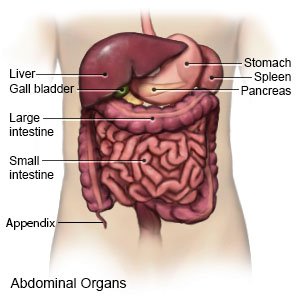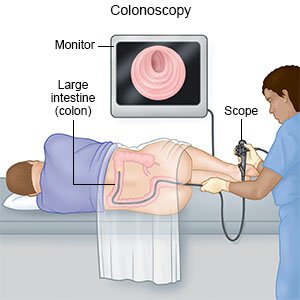Right Lower Quadrant (Rlq) Abdominal Pain
Medically reviewed by Drugs.com. Last updated on Aug 4, 2025.
What do I need to know about RLQ abdominal pain?
RLQ abdominal pain is felt in the lower right side of your abdomen. The RLQ is the area from the middle of your abdomen to your groin on the right side. The appendix and part of your intestine are in this area. In females, the right ovary and fallopian tube are also in this area. Acute pain usually lasts less than 3 months. Chronic pain lasts longer than 3 months. Your pain may be sharp or dull. The pain may stay in the same place or move around. You may have the pain all the time, or it may come and go. Depending on the cause, you may also have nausea, vomiting, fever, or diarrhea.
 |
What causes RLQ abdominal pain?
The following are common causes:
- An inflamed appendix
- Constipation, gas, or diarrhea
- Menstrual cramps or a growth or cyst on an ovary
- Kidney infection or stone
- Irritable bowel syndrome, inguinal hernia
How is the cause of RLQ abdominal pain diagnosed?
Your healthcare provider will check your abdomen. Your provider will ask where your pain is and when it started. Tell your provider if the pain wakes you or stops you from doing your daily activities. Describe anything that makes the pain better or worse. You may also need any of the following:
- Blood, urine, or bowel movement samples may be tested for signs of an infection, injury, or other medical condition.
- X-ray, ultrasound, CT, or MRI pictures may be used to check the organs inside your abdomen. You may be given contrast liquid to help the organs show up better in the pictures. Tell the healthcare provider if you have ever had an allergic reaction to contrast liquid. Do not enter the MRI room with anything metal. Metal can cause serious injury. Tell the healthcare provider if you have any metal in or on your body.
- A colonoscopy is a procedure to examine the inside of your colon (intestine) with a scope. A scope is a flexible tube with a small light and camera on the end. Polyps or tissue growths may be removed during your colonoscopy.

How is RLQ abdominal pain treated?
You may need any of the following:
- Acetaminophen decreases pain and fever. It is available without a doctor's order. Ask how much to take and how often to take it. Follow directions. Read the labels of all other medicines you are using to see if they also contain acetaminophen, or ask your doctor or pharmacist. Acetaminophen can cause liver damage if not taken correctly.
- NSAIDs , such as ibuprofen, help decrease swelling, pain, and fever. This medicine is available with or without a doctor's order. NSAIDs can cause stomach bleeding or kidney problems in certain people. If you take blood thinner medicine, always ask your healthcare provider if NSAIDs are safe for you. Always read the medicine label and follow directions.
- Prescription pain medicine may be given. Ask your healthcare provider how to take this medicine safely. Some prescription pain medicines contain acetaminophen. Do not take other medicines that contain acetaminophen without talking to your healthcare provider. Too much acetaminophen may cause liver damage. Prescription pain medicine may cause constipation. Ask your healthcare provider how to prevent or treat constipation.
- Other medicines may be given to calm your stomach or prevent vomiting.
- Surgery may be needed, depending on the cause.
Related medications
What can I do to manage or prevent RLQ abdominal pain?
- Keep a diary of your abdominal pain. A diary may help your provider learn what is causing your pain. Include when the pain happens, how long it lasts, and what the pain feels like. Write down any other symptoms you have with the abdominal pain. Also write down what you eat, and any symptoms you have after you eat.
- Apply heat on your abdomen for 20 to 30 minutes every 2 hours for as many days as directed. Heat helps decrease pain and muscle spasms.
- Make changes to the foods you eat, if needed. Do not eat foods that cause abdominal pain or other symptoms. Eat small meals more often. The following changes may also help:
- Eat more high-fiber foods if you are constipated. High-fiber foods include fruits, vegetables, whole-grain foods, and legumes such as pinto beans.

- Do not eat foods that cause gas if you have bloating. Examples include broccoli, cabbage, beans, and carbonated drinks.
- Do not eat foods or drinks that contain sorbitol or fructose if you have diarrhea and bloating. Some examples are fruit juices, candy, jelly, and sugar-free gum.
- Do not eat high-fat foods. Examples include fried foods, cheeseburgers, hot dogs, and desserts.
- Eat more high-fiber foods if you are constipated. High-fiber foods include fruits, vegetables, whole-grain foods, and legumes such as pinto beans.
- Make changes to the liquids you drink, if needed. Do not drink liquids that cause pain or make it worse, such as orange juice. Drink liquids throughout the day to stay hydrated. The following changes may also help:
- Drink more liquids to prevent dehydration from diarrhea or vomiting. Ask your healthcare provider how much liquid to drink each day and which liquids are best for you.
- Limit or do not have caffeine. Caffeine may make symptoms such as heartburn or nausea worse.
- Limit or do not drink alcohol. Alcohol can make your abdominal pain worse. Ask your provider if it is okay for you to drink alcohol. Also ask how much is okay for you to drink. A drink of alcohol is 12 ounces of beer, 1.5 ounces of liquor, or 5 ounces of wine.
- Manage stress. Stress may cause abdominal pain. Your provider may recommend relaxation techniques and deep breathing exercises to help decrease your stress. Your provider may recommend you talk to someone about your stress or anxiety, such as a counselor or a friend. Get plenty of sleep. Exercise regularly.

- Do not smoke. Nicotine and other chemicals in cigarettes can damage your esophagus and stomach. Ask your provider for information if you currently smoke and need help to quit. E-cigarettes or smokeless tobacco still contain nicotine. Talk to your provider before you use these products.
Call your local emergency number (911 in the US) if:
- You have chest pain or shortness of breath.
When should I seek immediate care?
- You have pulsing pain in your upper abdomen or lower back that suddenly becomes constant.
- Your pain becomes severe.
- You have a fever over 100.4°F (38°C) or shaking chills.
- You are vomiting and cannot keep food or liquids down.
- You see blood in your vomit or bowel movements, or they look black and tarry.
- Your skin or the whites of your eyes turn yellow.
- You have a large amount of vaginal bleeding that is not your monthly period.
When should I call my doctor?
- You have pain in your lower back.
- You have pain in your testicles.
- You have pain when you urinate.
- You have questions or concerns about your condition or care.
Care Agreement
You have the right to help plan your care. Learn about your health condition and how it may be treated. Discuss treatment options with your healthcare providers to decide what care you want to receive. You always have the right to refuse treatment. The above information is an educational aid only. It is not intended as medical advice for individual conditions or treatments. Talk to your doctor, nurse or pharmacist before following any medical regimen to see if it is safe and effective for you.© Copyright Merative 2025 Information is for End User's use only and may not be sold, redistributed or otherwise used for commercial purposes.
Further information
Always consult your healthcare provider to ensure the information displayed on this page applies to your personal circumstances.
